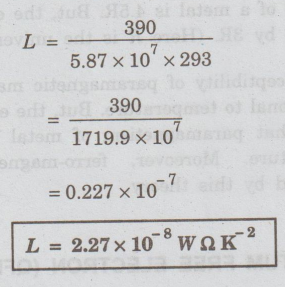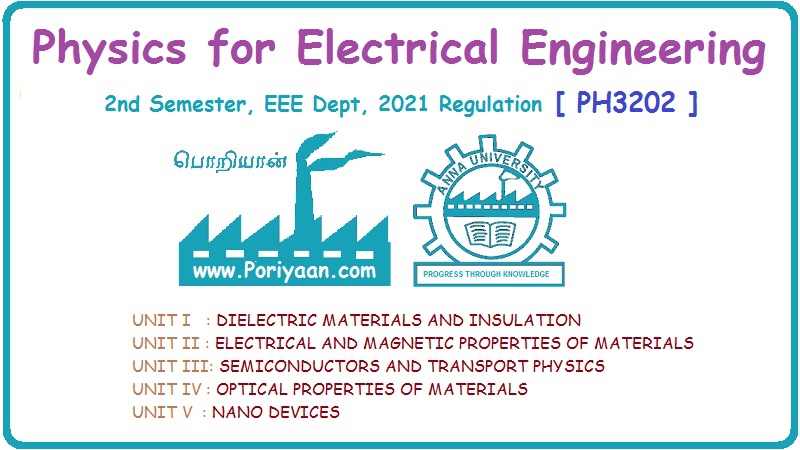Physics for Electrical Engineering: Unit II: a. Electrical Properties of Materials
Anna university solved problems
Electrical Properties of Materials | Physics for Electrical Engineering
Physics for Electrical Engineering: Unit II: Electrical and Magnetic Properties of Materials : Anna university solved problems
ANNA UNIVERSITY
SOLVED PROBLEMS
Problem 2.1
The electrical resistivity of copper
at 27 °C is 1.72 × 10-8 Ωm. Compute its thermal conductivity if the Lorentz
number is 2.26 × 10-8 WΩK-2. (A.U.
April 2014)
Given data
Electrical
resistivity ρ = 1.72 × 10- 8Ωm
Temperature
T = 27 °C= 27+273 = 300 K
Lorentz
number L = 2.26 × 10-8 WΩK-2
Solution
We
know that Wiedemann - Franz law
K
/ σ = LT
K
= σ LT
K
= LT / ρ σ = 1 / ρ
Substituting
the given values, we have

K
= 394 Wm-1K-1
Problem
2.2
The thermal and electrical
conductivities of copper at 20 °C are 390 Wm-1K-1 and
5.87 × 107 Ω-1m-1 respectively. Calculate
Lorentz number. (A.U. May 2012)
Given data
Thermal
conductivity of copper K = 390 Wm-1K-1
Electrical
conductivity of copper σ = 5.87 × 107 Ω-1m-1
Temperature
T = 20 °C = (20+273) = 293 K
Solution
We
know that Lorentz number L = K / σ T
Substituting
the given values, we have

L = 2.27 × 10-8 WΩ K-2
Success of Classical Free Electron
Theory
•
It is used to verify Ohm's law.
•
It is used to explain electrical and thermal conductivities 3 up as w of
metals.
•
It is used to derive Wiedemann-Franz law.
•
It is used to explain the optical properties of metals.
Failures of Classical Free Electron
(CFE) Theory
•
Classical theory states that all the free electrons absorb the supplied energy.
But, the quantum theory states that only a few electrons absorb the supplied
energy.
•
The electrical conductivity of semiconductors insulators cannot be explained by
this theory.
•
The photo-electric effect, Compton effect and black body radiation cannot be
explained on the basis of classical free electron theory.
•
According to the classical free electron theory, the ratio K /σ τ is constant
at all temperatures. But, it is found that it is not constant at low
temperature.
•
According to this theory, the value of specific heat capacity of a metal is
4.5R. But, the experimental value is given by 3R. (Here R is the universal gas
constant.)
• The susceptibility of paramagnetic material is inversely proportional to temperature. But, the experimental result shows that paramagnetism of metal is independent of temperature. Moreover, ferro-magnetism cannot be explained by this theory.
Physics for Electrical Engineering: Unit II: a. Electrical Properties of Materials : Tag: : Electrical Properties of Materials | Physics for Electrical Engineering - Anna university solved problems
Related Topics
Related Subjects
Physics for Electrical Engineering
PH3202 2nd Semester 2021 Regulation | 2nd Semester EEE Dept 2021 Regulation
